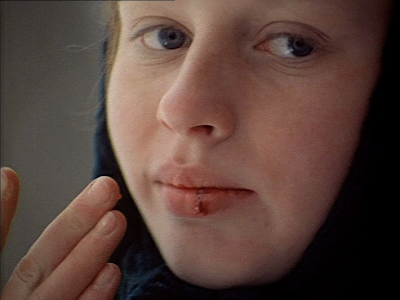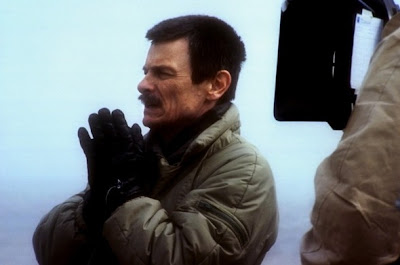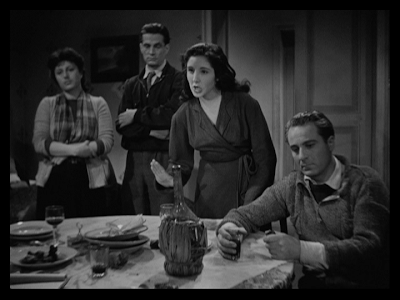 The MirrorA Film by Andrei Tarkovsky
The MirrorA Film by Andrei TarkovskyCountry:Russia
Year:1975
Runtime :141 minutes
Russian with English subtitles
8th May 2011;5.45pm
PERKS MINI THEATER
http://konangalfilmsociety.blogspot.com
Two documentaries related to Tarkovsky
and The Mirror will be screened
along with the main feature.
Mirror is a direct image of time created by a flux of thought-images (or thought-waves) propagating in the time-memory universe of Alexei’s mind. Mirror is Andrei Tarkovsky's visually transcendent, artistically revelatory autobiographical film on lost innocence and emotional abandonment.

Each cut is an event, a moment not simply to collide images but also to layer the collage of the film: picture and sound, married and abutted, proffering new sights, new landscapes, new emotions and new realities in light. Andrei Tarkovksy’s Mirror is full of such event-cuts, each defining or sensing the cohesive whole of the film, like its maker, as discrete moments hung together through time, however disparate and dispersed its instances, like his limbs, may seem.
 Presented as a languidly paced, achronological cinematic montage of modern day life, personal memories, historical news footage, and dreams, Mirror is an introspective journey through the course of human existence, hope and despair, success and frailty: a television broadcast of a young man seemingly cured from stuttering through hypnosis; a neglected wife (Margarita Terekhova) humoring a village doctor who has lost his way; a custodial argument between a faceless narrator (Innokenty Smoktunovsky) and his ex-wife; a precocious young man trying the patience of his military instructor (Yuri Nazarov).
Presented as a languidly paced, achronological cinematic montage of modern day life, personal memories, historical news footage, and dreams, Mirror is an introspective journey through the course of human existence, hope and despair, success and frailty: a television broadcast of a young man seemingly cured from stuttering through hypnosis; a neglected wife (Margarita Terekhova) humoring a village doctor who has lost his way; a custodial argument between a faceless narrator (Innokenty Smoktunovsky) and his ex-wife; a precocious young man trying the patience of his military instructor (Yuri Nazarov).
Andrei Tarkovsky deliberately obscures time by using the same actors to portray the two phases of the narrator's life: the fatherless boy attempting to reach out to his distracted mother, and the distant father unable to relate to his self-absorbed son.
 Instead of simply reflecting, Tarkovsky’s Mirror refracts light through the prism of memory, itself a condensation of time. Each event—that is, each cut, each encounter, each memory flashed back or forward—in the film’s networked composite is skewed by the film’s narrator. This narrator is the camera, and the film. His face is never seen. We are denied an identifying reverse shot. We are simply presented with his point of view.
Instead of simply reflecting, Tarkovsky’s Mirror refracts light through the prism of memory, itself a condensation of time. Each event—that is, each cut, each encounter, each memory flashed back or forward—in the film’s networked composite is skewed by the film’s narrator. This narrator is the camera, and the film. His face is never seen. We are denied an identifying reverse shot. We are simply presented with his point of view.
To attempt to conform these images into some coherent plot or universal conclusion is meaningless. After all, Mirror is a reflection of Tarkovsky's haunted soul: his search for spirituality, connection, Truth - exposed through indelible images that inevitably define our own imperfect lives, however trivial or mundane.

Andrei Tarkovsky
Andrei Tarkovsky is almost certainly the most famous Russian filmmaker since Eisenstein. His visionary approach to cinematic time and space, as well as his commitment to cinema as poetry, mark his oeuvre as one of the defining moments in the development of the modern art film. Although he never tackled politics directly, the metaphysical preoccupations of films such as Andrei Rublev (1966), Mirror (1974) and Stalker (1979) provoked ongoing hostility from the Soviet authorities. Like many other artists in the Soviet Union, his career was marked by constant struggles with the authorities to realise his vision. Although this meant he completed only seven features in his 27 years as a director, each one is strikingly uncompromising in its thematic ambition and formal boldness. Whether or not he would have fared better under the capitalist film industry in the West is open to debate – Bresson and Dreyer, for example, both suffered frequent frustrations in creating their formally radical investigations into human spirituality.

Tarkovsky was born in 1932 in Zavrzhe in what is now Belorus. He was the son of noted poet Arseni Tarkovski and actress Maria Ivanovna. His parents divorced while he was still a child. His father’s poetry features in Mirror, Stalker and Nostalgia (1983) and his mother appears in Mirror.
Tarkovsky studied Arabic at the Moscow Institute of Oriental Languages between 1951 and 1954 and geology in Siberia, before enrolling in the famous VGIK Moscow film school in 1959. His teacher was Mikhail Romm. While there, he worked on a short piece for television There Will Be No Leave Today (1959). His prize-winning graduation short, The Steamroller and the Violin (1960), was written in collaboration with future director Andrei Mikhalkov-Konchalovsky who would also work on the Andrei Rublev script.
His first feature, Ivan’s Childhood (1962), was an adaptation of a war story by Vladimir Bogomolov.van’s Childhood won its director notice in the West by being awarded the Golden Lion at Venice.Andrei Rublev displayed an enormous advance in Tarkovsky’s technique. Vividly textured images of nature abound in Tarkovsky’s cinema, with the four elements – earth, air (in the form of wind), fire and water – highlighted time and again. Even the still-occupied rural homes in Mirror and The Sacrifice (1986) are isolated in the countryside, vulnerable to the ever-present elements.
Another landscape important to Tarkovsky is that of the human face. Like Garrel and Pasolini, he is one of cinema’s great portraitists. His camera lingers on his actors’ faces.Tarkovsky made prominent use of actual paintings in many of his films.
In the early 1980s, Tarkovsky left Russia permanently. The few remaining years of his life were plagued by a constant struggle with the Soviet authorities to allow his family, particularly his young son, to join him. His filmmaking career started again in Italy. By the time Tarkovsky started work on his next and final film, The Sacrifice, he knew he was seriously ill with cancer. A Swedish production, The Sacrifice is an allegory of self-sacrifice.Tarkovsky died in 1986 and is buried in Paris. His influence is visible in the work of several major contemporary directors.



 His father was a painter and poet at the court of Frederico da Montefeltre, one of the most famous princes and art patrons of Early Renaissance Italy. It is believed that Raphael learnt the fundamentals of art in his father's studio.Raphael was apprenticed to Perugino.
His father was a painter and poet at the court of Frederico da Montefeltre, one of the most famous princes and art patrons of Early Renaissance Italy. It is believed that Raphael learnt the fundamentals of art in his father's studio.Raphael was apprenticed to Perugino. His father was a painter and poet at the court of Frederico da Montefeltre, one of the most famous princes and art patrons of Early Renaissance Italy. It is believed that Raphael learnt the fundamentals of art in his father's studio.Raphael was apprenticed to Perugino.
His father was a painter and poet at the court of Frederico da Montefeltre, one of the most famous princes and art patrons of Early Renaissance Italy. It is believed that Raphael learnt the fundamentals of art in his father's studio.Raphael was apprenticed to Perugino. In 1504, Raphael moved to Florence, where he remained until 1508. These years were very important for his development. He studied works of Leonardo da Vinci and Michelangelo there, by which he was greatly influenced. Yet he proved, that his ability to adapt from others what was necessary to his own vision and to reject what was incompatible with it was faultless. In Florence he started his series of Maddonnas, whose charm has captured popular imagination ever since.
In 1504, Raphael moved to Florence, where he remained until 1508. These years were very important for his development. He studied works of Leonardo da Vinci and Michelangelo there, by which he was greatly influenced. Yet he proved, that his ability to adapt from others what was necessary to his own vision and to reject what was incompatible with it was faultless. In Florence he started his series of Maddonnas, whose charm has captured popular imagination ever since. Within four years Raphael had achieved success in Florence and his fame had spread abroad. By the autumn of 1508, he was in Rome and was entrusted by Pope Julius II with the decoration of the Stanze, the new papal apartment in the Vatican Palace, an enormous commission for the 26-year-old artist. It was nevertheless a triumph.
Within four years Raphael had achieved success in Florence and his fame had spread abroad. By the autumn of 1508, he was in Rome and was entrusted by Pope Julius II with the decoration of the Stanze, the new papal apartment in the Vatican Palace, an enormous commission for the 26-year-old artist. It was nevertheless a triumph. Under the new Pope Leo X Raphael held an important position in the papal court. Besides combining positions of painter, architect (he was Chief Architect of St. Peter's cathedral) and archeologist, he initiated the first comprehensive survey of the antiquities of Rome. Although Raphael's main task during this period was to decorate Stanza, he still found time for a subject, which preoccupied him for a long time: Madonna and Christ Child.
Under the new Pope Leo X Raphael held an important position in the papal court. Besides combining positions of painter, architect (he was Chief Architect of St. Peter's cathedral) and archeologist, he initiated the first comprehensive survey of the antiquities of Rome. Although Raphael's main task during this period was to decorate Stanza, he still found time for a subject, which preoccupied him for a long time: Madonna and Christ Child. The Transfiguration (c.1519-1520), was the last work Raphael painted. It was commissioned by Cardinal Giulio de' Medici. Raphael died unexpectedly on 6th April 1520. The Transfiguration was complete.
The Transfiguration (c.1519-1520), was the last work Raphael painted. It was commissioned by Cardinal Giulio de' Medici. Raphael died unexpectedly on 6th April 1520. The Transfiguration was complete.




















